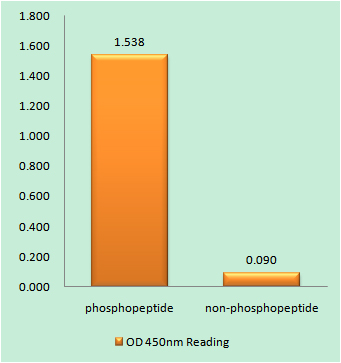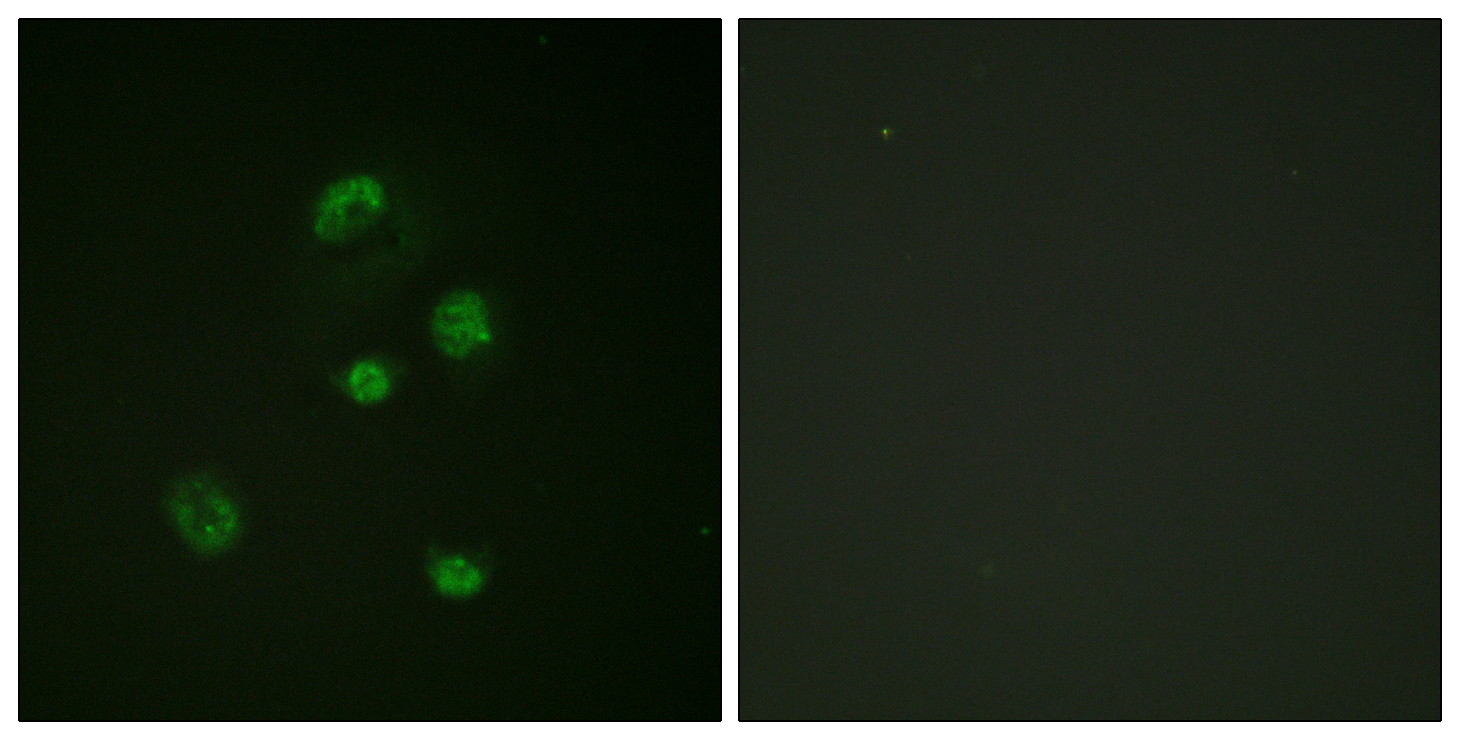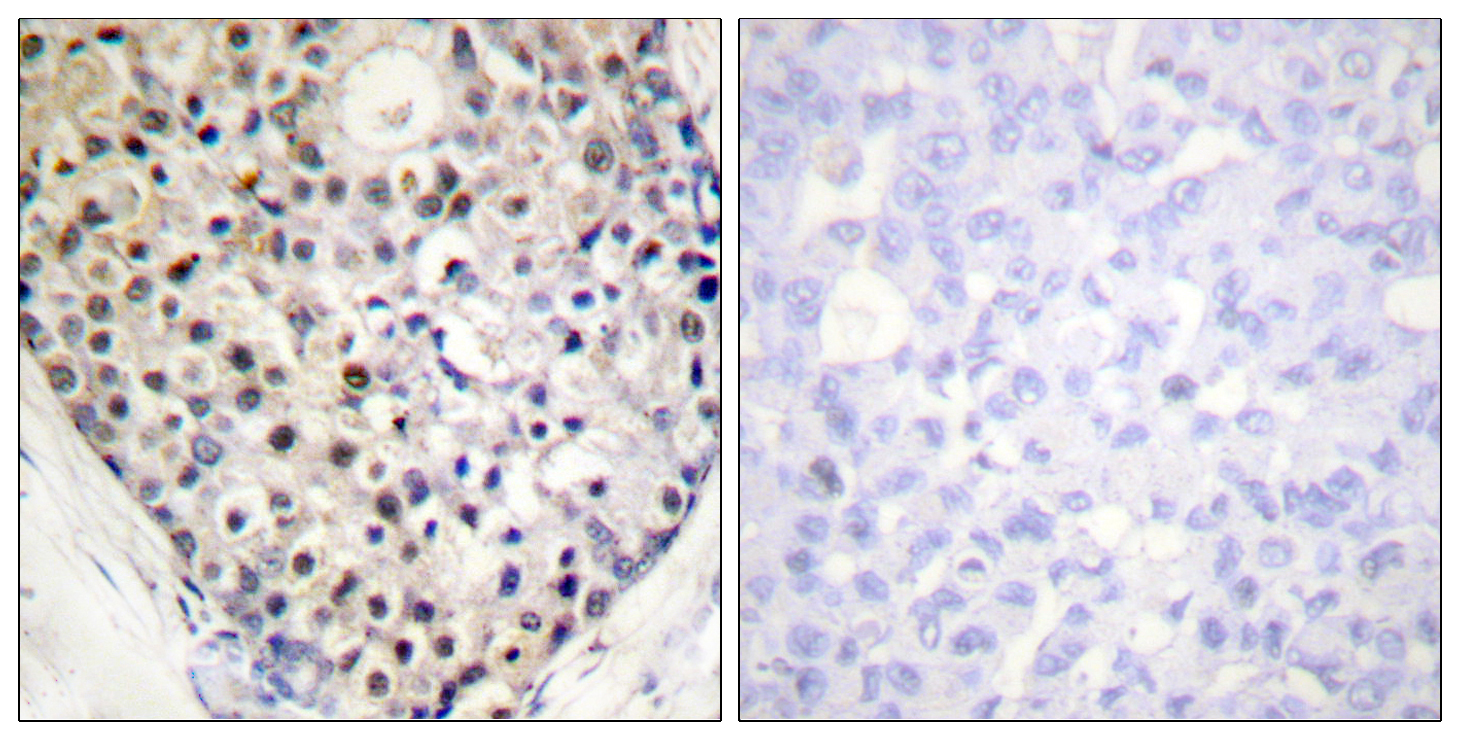CHOP (phospho Ser30) Polyclonal Antibody
- Catalog No.:YP0915
- Applications:WB;IHC;IF;ELISA
- Reactivity:Human;Mouse
- Target:
- CHOP
- Fields:
- >>MAPK signaling pathway;>>Protein processing in endoplasmic reticulum;>>Apoptosis;>>Non-alcoholic fatty liver disease;>>Alzheimer disease;>>Parkinson disease;>>Amyotrophic lateral sclerosis;>>Prion disease;>>Pathways of neurodegeneration - multiple diseases;>>Transcriptional misregulation in cancer;>>Lipid and atherosclerosis
- Gene Name:
- DDIT3
- Protein Name:
- DNA damage-inducible transcript 3 protein
- Human Gene Id:
- 1649
- Human Swiss Prot No:
- P35638
- Mouse Gene Id:
- 13198
- Mouse Swiss Prot No:
- P35639
- Immunogen:
- The antiserum was produced against synthesized peptide derived from human CHOP around the phosphorylation site of Ser30. AA range:15-64
- Specificity:
- Phospho-CHOP (S30) Polyclonal Antibody detects endogenous levels of CHOP protein only when phosphorylated at S30.
- Formulation:
- Liquid in PBS containing 50% glycerol, 0.5% BSA and 0.02% sodium azide.
- Source:
- Polyclonal, Rabbit,IgG
- Dilution:
- WB 1:500 - 1:2000. IHC 1:100 - 1:300. IF 1:200 - 1:1000. ELISA: 1:20000. Not yet tested in other applications.
- Purification:
- The antibody was affinity-purified from rabbit antiserum by affinity-chromatography using epitope-specific immunogen.
- Concentration:
- 1 mg/ml
- Storage Stability:
- -15°C to -25°C/1 year(Do not lower than -25°C)
- Other Name:
- DDIT3;CHOP;CHOP10;GADD153;DNA damage-inducible transcript 3 protein;DDIT-3;C/EBP-homologous protein;CHOP;C/EBP-homologous protein 10;CHOP-10;Growth arrest and DNA damage-inducible protein GADD153
- Observed Band(KD):
- 19kD
- Background:
- This gene encodes a member of the CCAAT/enhancer-binding protein (C/EBP) family of transcription factors. The protein functions as a dominant-negative inhibitor by forming heterodimers with other C/EBP members, such as C/EBP and LAP (liver activator protein), and preventing their DNA binding activity. The protein is implicated in adipogenesis and erythropoiesis, is activated by endoplasmic reticulum stress, and promotes apoptosis. Fusion of this gene and FUS on chromosome 16 or EWSR1 on chromosome 22 induced by translocation generates chimeric proteins in myxoid liposarcomas or Ewing sarcoma. Multiple alternatively spliced transcript variants encoding two isoforms with different length have been identified. [provided by RefSeq, Aug 2010],
- Function:
- disease:A chromosomal aberration involving DDIT3 is found in a form of malignant myxoid liposarcoma [MIM:126337]. Translocation t(12;16)(q13;p11) with FUS.,function:Inhibits the DNA-binding activity of C/EBP and LAP by forming heterodimers that cannot bind DNA.,similarity:Belongs to the bZIP family.,similarity:Contains 1 bZIP domain.,subunit:Heterodimer.,
- Subcellular Location:
- Cytoplasm . Nucleus . Present in the cytoplasm under non-stressed conditions and ER stress leads to its nuclear accumulation. .
- Expression:
- Muscle,Skeletal muscle,
- June 19-2018
- WESTERN IMMUNOBLOTTING PROTOCOL
- June 19-2018
- IMMUNOHISTOCHEMISTRY-PARAFFIN PROTOCOL
- June 19-2018
- IMMUNOFLUORESCENCE PROTOCOL
- September 08-2020
- FLOW-CYTOMEYRT-PROTOCOL
- May 20-2022
- Cell-Based ELISA│解您多样本WB检测之困扰
- July 13-2018
- CELL-BASED-ELISA-PROTOCOL-FOR-ACETYL-PROTEIN
- July 13-2018
- CELL-BASED-ELISA-PROTOCOL-FOR-PHOSPHO-PROTEIN
- July 13-2018
- Antibody-FAQs
- Products Images

- Enzyme-Linked Immunosorbent Assay (Phospho-ELISA) for Immunogen Phosphopeptide (Phospho-left) and Non-Phosphopeptide (Phospho-right), using CHOP (Phospho-Ser30) Antibody

- Immunofluorescence analysis of A549 cells, using CHOP (Phospho-Ser30) Antibody. The picture on the right is blocked with the phospho peptide.

- Immunohistochemistry analysis of paraffin-embedded human breast carcinoma, using CHOP (Phospho-Ser30) Antibody. The picture on the right is blocked with the phospho peptide.

- Western blot analysis of lysates from Jurkat cells treated with PMA 125ng/ml 30', using CHOP (Phospho-Ser30) Antibody. The lane on the right is blocked with the phospho peptide.



